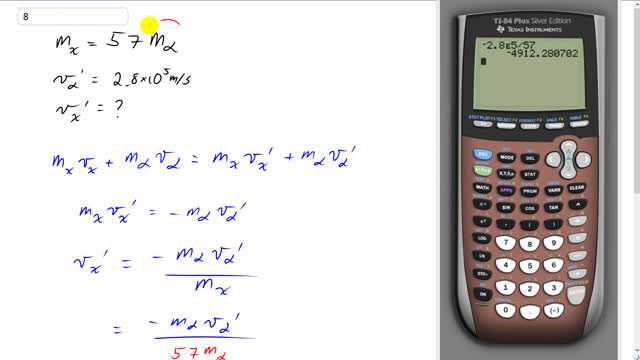
An atomic nucleus at rest decays radioactively into an alpha particle and a different nucleus. What will be the speed of this recoiling nucleus if the speed of the alpha particle is ? Assume the recoiling nucleus has a mass 57 times greater than that of the alpha particle.

In order to watch this solution you need to have a subscription.
This is Giancoli Answers with Mr. Dychko. We'll start by writing down the information that we know; the mass of this unknown nucleus, we'll call it nucleus x, is 57 times the mass of the alpha particle and the velocity of the alpha particle after this radioactive decay event is 2.8 times 10 to the 5 meters per second and we don't know the velocity of this other particle and we have to figure it out. And we know that both the particles are at rest in this single combined nucleus before the radioactive decay so that means both of these terms are zero in our conservation of momentum formula. This is the velocity of the unknown nucleus and this is the velocity of the alpha particle before the decay event and they both start at rest. So we'll solve for v x prime, that's our job, and we'll move this term to the left side making it negative or subtract it from both sides would be another way of saying that and then we'll switch the sides around so we have this unknown v x prime on the left. So m x times v x prime equals negative m αv α prime and divide both sides by m x and we get that the velocity of this x particle prime equals negative α mass times α velocity prime divided by mass of the unknown nucleus. And we can substitute for the mass of this unknown nucleus by writing 57 times mass of the α particle and it turns out that these α particle masses will cancel and so it doesn't even matter how many kilograms the α particle is, the only thing that matters is the factor by which the masses are different between the α particle and the unknown nucleus and they are different by a factor of 57 so we can write in 57 times m α here and the m α's cancel. So our answer then is the velocity of the unknown particle will be the velocity to the α particle divided by 57 and that gives us negative 4.9 times 10 to the 3 meters per second. And to find the speed then take the absolute value of that and that's gonna be 4.9 times 10 to the 3 meters per second.